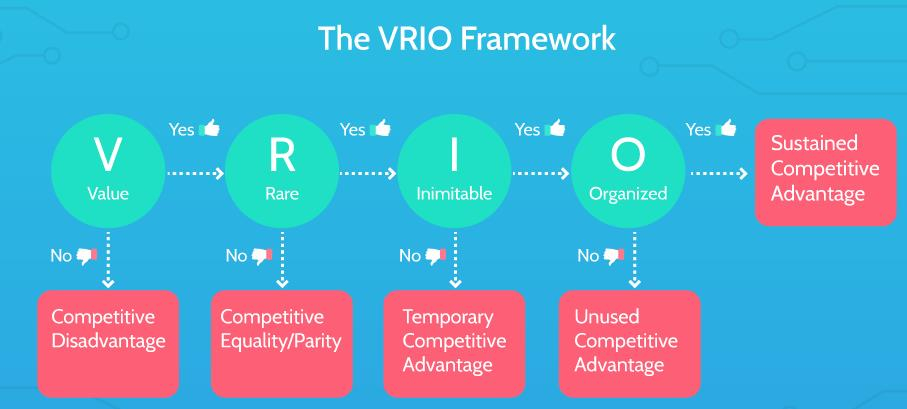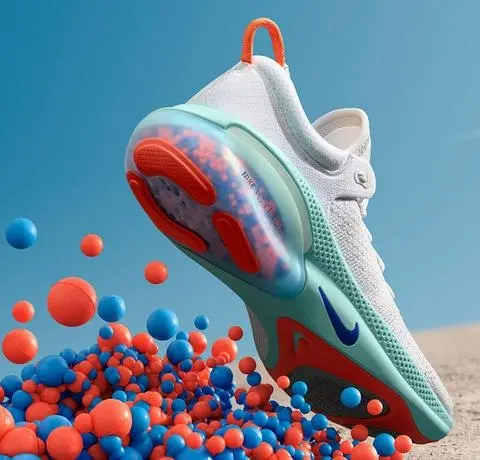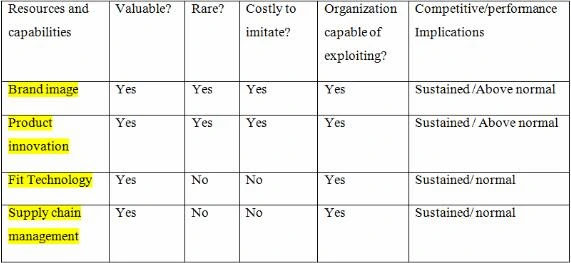Significance Of VRIO Analysis In Nike
Question
Task: Discuss about the significance of VRIO Analysis with the help of Nike.
Answer
Introduction
VRIO framework is used to examine internal resources and capabilities of a firm to establish its competitive advantage. VRIO constitutes Value, Rareness, Imitability and Organization. VRIO analysis was developed by Jay B. Barney in 1991 to evaluate the resources of a firm which includes financial resources, material resources, human resources and non-material resources. As per his opinion, the resources should be valuable, rare, inimitable and having no substitute. It helps a firm to note down its advantages as compared to its competitors. VRIO analysis is an improved version of VRIN which stands for Valuable, rare, imperfectly imitable and non- substitutable. The present discussion will help in analyzing the tool, its different components with reference to Nike and its competitive advantage.
How does VRIO analysis work?
VRIO analysis helps in evaluating the resources of the firm. When the firm is able to understand its resources it helps to gain a competitive advantage and to work upon its weakness. VRIO analysis helps the firm to evaluate its internal environment and work on the improvement areas (Lopes, Farinha, Ferreira and Silveira, 2018). The tool helps in strategic management and in taking a better business decision. When one of the resources is not adding a value then it should be outsourced. When the resource is not rare but it is valuable, the firm is still competitive. When the resource is rare and valuable but not too costly, it still provides a competitive advantage but for a limited period (Donnellan and Rutledge, 2019). When the resource is rare, valuable and costly, it provides a competitive advantage and the firm has to maintain the advantage to gain a consistent and permanent competitive advantage.
What are the components of VRIO analysis?
The framework is best suited to know about the resources of a firm, its strength and weakness which can help it to gain a competitive advantage. The four dimensions of the VRIO as depicted in the below image are being discussed below:

Source: (Carter, 2019)
- Value: This dimension of the VRIO analysis helps to assess the usefulness of the resource in the form of its worth, availability, rented or leased and whether it is to be purchased or not. If the resource is expensive then it’s better to outsource it or provide it on rent. If it is seen that the rent is too huge then the option to buy would be a good idea. Examining the firm’s value chain would also be a good method to identify the resources. It is necessary to critically analyze all the factors involved in the process. If the resource is able to exploit different opportunities and defend itself from the threats then it is considered as a valuable resource. When the perceived customer value increases, the resources become valuable and this can be done by a decreased price of the product (Carter, 2019). If the resource is unable to meet the required standards then it creates a disadvantage for the firm. A regular review of the resources is required in order to meet up with the changing conditions.
- Rareness: This dimension of the VRIO analysis helps to note down the rarity or scarcity of the resource while purchasing. When the resource is valuable without being scarce, it may help in the comparison with the competitors. If the resource is expensive and scarce then it may be beneficial for the firm. The logic behind this dimension is more scarcity will provide greater competitive advantage by keeping the competition aside. When the resources are abundant in nature then no firm will be in a position to claim competitive advantage. A firm should always look to maintain the valuable resources and capabilities as it helps in bringing stability in the market.
- Imitability: This dimension of the VRIO analysis helps to note down the extent of imitation of the resources which can be practiced by the competitors. When the resource can be easily imitated then it does not provide a competitive advantage but when it is tough to imitate the resource then the firm can have a competitive advantage (Donnellan and Rutledge, 2019). Imitating may lead to higher costs and generating low quality products. Some of the firms may apply for patent of the resources produced by them which provides an assurance from imitation. Imitation can be done in two ways, either a direct imitation or producing a substitute of the original resource. According to Barney (1991) there are three reasons behind inability to imitate and the first is a historical condition wherein the resources were developed due to the occurrence of some historical events and it is not easier to imitate due the costs involved. Secondly, causal ambiguity in which the firm is unable to identify the resource which is providing a competitive advantage to the other. The last is social complexity based upon cultural and interpersonal relations.
- Organization: This dimension of the VRIO analysis helps to note down the positioning of the task and actions. Many resources are involved to create a product like ordering the resources, agreeing on the price, making comparisons and its assembly. Each and every department of a firm is required to be involved in the creation of the product and the employees must be aware and apprised about their duties and what the firm expects from them. Resources needs to be used efficiently as simply having it cannot provide a competitive advantage (Carter, 2019). A firm should always look into the functioning of its internal administration in order to ensure that the all the elements are used fully to develop the product.
When all the above dimensions of the VRIO analysis have been determined, it will help in realizing the ultimate product. A better and vigilant internal administration may lead to greater competitive advantage.
VRIO analysis of Nike
Nike is an American company founded in the year 1964. It is involved into making and marketing of footwear, clothing, accessories and services. The analysis will be done on Nike’s brand, innovation in its products, fit technology and its supply chain management.

Source: (Kim, 2019)
The analysis will help in evaluating the resources and capabilities and the competitive advantage of Nike.

Fig: VRIO analysis of Nike
- Brand Image: Nike is considered as a big brand which is the biggest strength for the company. Consumers recognize it as a valuable service which leads to building trust and continually usage of the products and services. Athletes are regular user of Nike which attracts consumers to buy the products. Its brand image cannot be reached by any of its competitors which can be seen from the consumer feedback. The quality being delivered by Nike meets the expectation of the consumers. Imitating the image of the company will involve huge costs and time. Nike has been working upon its products and services basis the feedback being shared by the consumers including athletes. The company is into introducing new products and improving the existent products to meet the expectations of its consumers (Kim, 2019). Its brand image helps in creating a competitive advantage over other competitors. The company meets all the dimensions of the VRIO analysis and is performing above normal.
- Product innovation: Making innovation in its products and services is the forte of Nike. The team at Nike is quick to analyze the changing needs of its consumers which help it to introduce the products in the market in a short span of time. But there are other companies as well like Adidas and Reebok which has been into introducing innovation in its products but they are unable to meet the innovations being done by Nike due to the cost involved (Hofmann, Gold and Curtin, 2019). Through innovations the company is able to maintain its trust among the athletes and its users in turn creating a competitive edge. The company meets all the dimensions of the VRIO analysis and is performing above normal.
- Fit Technology: The fit technology adds value to its products and services. It helps athletes to exercise comfortably as it reduces sweat and keeps them dry. But Adidas and Reebok are also into making such products which can control sweat and it is not tough for such companies to imitate this character of Nike. Nike uses polyester which is cheap and easily available. It is able to introduce the new products in countries where wearing polyester fabric clothes are new or less common. The fit technology of the company provides a competitive advantage to the company and helps in performing normally.
- Supply chain management: The Company is able to manufacture its products from China and Vietnam which helps in reducing its labor cost. When the cost of labor is cheap it allows the company to save more (Kim, 2019). When the labor is in abundance it helps the company to produce more products at a faster pace. The same technique is being used by Adidas and the costs involved in imitation is less. Nike is finding new markets and making improvements in its network to maintain the completive advantage and perform normally.
Describing different dimensions of VRIO in relation to Nike
Internal resources of Nike will be assessed through VRIO analysis which will help in establishing whether the company has maintained the competitive advantage or not. The analysis will mention about the improvement areas.
- Valuable: Nike uses its financial resources to a greater extent which helps it to combat all threats. Nike has a set of trained and loyal employees who add value to the company and remain associated with the company for a longer time. Nike has achieved patent in its products which eliminates competition. Nike has a perfect distribution network which adds as a valuable resource (Andersen and Samuelsson, 2016). They reach out to maximum people by using efficient tactics. The product reach and promotion helps Nike to maintain profits. A lot of cost is involved in the manufacturing process which creates a disadvantage for the company and affects its profits. Nike analyses the customer feedback and their expectations to make innovations but this involves a lot of cost which is not valuable. The research and development team needs to be improved in order to restrict the costs involved in the process.
- Rare: Nike possesses some rare and strong financial resources which sets it apart from its competitors. The employees of the company are satisfied with association and Nike ensures to retain them by providing better working conditions along with lucrative compensations. This arrangement ensures employee stability and the company helps itself to curb the need of employees to join its competitors. As discussed previously, Nike has maintained patents on some of its products in order to avoid any competition. This helps them to be the sole supplier and maker of a particular set of products. Nike has a great distribution network and its competitors are unable to meet the investment and the time involved to improve its distribution networks (Hofmann, Gold and Curtin, 2019).
- Imitable: Imitating the financial resource of the company is tough for its competitors. The resources have been accumulated by Nike by serving its consumers since a long time and maintaining the profit over the time. It will take a very long time for any new competitor to acquire those resources as acquired by Nike. Imitating or hiring employees from Nike is possible if the competitor is able to influence the employee. Influencing the employees can be done by offering them better compensation, better position, more benefits, easy and friendly working conditions, etc. The products on which Nike has a patent cannot be imitated giving them an edge from the other competitors. Distribution network of the company is very strong which has been developed gradually. Competitors will have to make greater investments to meet the distribution strategy of Nike.
- Organization: Nike organizes its financial resources in order to add value and makes correct investment decisions at the right time. This attitude of the company helps in eliminating and meeting any threat and provides a competitive advantage. Nike has patents on some of its products but they are not well organized (Ahmed et al, 2016). Nike is unable to use the patents to its advantage. Nike needs to manufacture and sale all its products which has gained patent before the right expires. The company has a great distribution network which helps it to reach out different consumers at different places within a minimum time. It ensures that its products are easily available at all the outlets. This approach helps Nike to maintain the competitive advantage.
Conclusion
In conclusion it can be clearly stated that VRIO analysis helps a firm or a company to analyze its competitive advantage in the market. It helps in eliminating the factors which are not useful for the company in the long run and can create a hurdle in its success and growth. Through the analysis of the resources and capabilities of Nike, it could be seen that it has an advantage in the form of financial resources and distribution networks but it needs to work upon gaining an advantage from the patented products and should build some strategies to hold back the employees.
Reference List
Ahmed, R.R., Brohi, H., Bhutto, A.H., Prithiani, J., Khubchandani, R., Kumar, S and Abbas, Z. (2016) Strategic Marketing Plan of Nike. Reserchgate. Retrieved from: https://s3.amazonaws.com/academia.edu.documents/53407396/Marketing_Plan_-_Nike.pdf?response-content-disposition=inline%3B%20filename%3DStrategic_Marketing_Plan_of_Nike_The_Cre.pdf&X-Amz-Algorithm=AWS4-HMAC-SHA256&X-Amz-Credential=AKIAIWOWYYGZ2Y53UL3A%2F20200219%2Fus-east-1%2Fs3%2Faws4_request&X-Amz-Date=20200219T091646Z&X-Amz-Expires=3600&X-Amz-SignedHeaders=host&X-Amz-Signature=c0b5aa270c587a2187fb77a004a5d42289b093b962e78cf3715865cbe0f118a7
Andersen, J and Samuelsson, J. (2016) Resource organization and firm performance: How entrepreneurial orientation and management accounting influence the profitability of growing and non-growing SMEs. International Journal of Entrepreneurial Behavior & Research, 22 (4), pp. 466-484
Barney, J. (1991) Firm Resources and Sustained Competitive Advantage. Journal of Management, 17(1).
Carter, T.J. (2019) What is VRIO? The 4-Step Framework for Continuous Business Success.Retrieved from: https://www.process.st/vrio/
Donnellan, J and Rutledge, W.L. (2019) A case for resource?based view and competitive advantage in banking. Managerial and Decision Economics, 40(6), pp. 728-737.
Hofmann, A., Gold, N and Curtin, C. (2019) Nike, Inc: Late Arrival to the 'Athleisure-wear' Trend. Retrieved from: https://repub.eur.nl/pub/116051/
Kim, M. (2019) Nike's New Joyride Sneakers Made Me Actually Like Running. Retrieved from: https://www.esquire.com/style/mens-fashion/a28626377/nike-joyride-flyknit-sneakers-review-wear-test/
Lopes, J., Farinha, L., Ferreira, J.J and Silveira, P. (2018) Does regional VRIO model help policy-makers to assess the resources of a region? A stakeholder perception approach. Land use Policy, 79, pp. 659-670.












